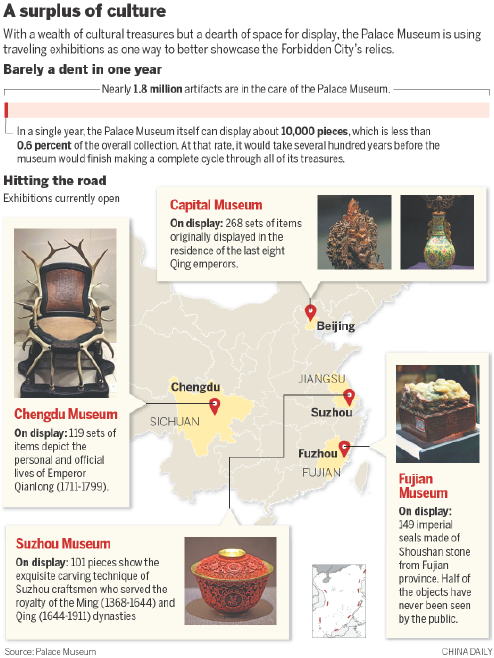
The Palace Museum, with most of its 1.8 million relics in storage, is opening new displays andloaning more artifacts.
Few of the 15 million visitors who pass through the world's most visited museum have any ideaabout the true size of its massive collection.
The great bulk of the 1.8 million treasures under the care of the Palace Museum in Beijing ishidden from public view because the museum has only enough space to display about 10,000items a year.
But the museum, which turns 91 on Monday, is continuing to look for new ways to bettershowcase its priceless collection.
After 18 exhibitions at the museum last year to mark its 90th anniversary, it is now intent onensuring that relics stored there are given a lot more exposure.
The museum, also known as the Forbidden City, was home to 24 emperors from the Ming (1368-1644) and Qing (1644-1911) dynasties, until China abolished the monarchy.
"It doesn't matter how many collections a museum has if they are all in storage," Shan Jixiang, themuseum director, told China Daily recently.
"The most important thing is how many are exhibited. If we were to rely on our current exhibitionspace and the time required for shows, it would take several hundred years to exhibit them all,"Shan said.
The museum is now giving its relics much greater exposure by lending them to other venues inChina. Four exhibitions of treasures from the museum are now taking place at other museums-in Beijing, Chengdu, Suzhou and Fuzhou.
For the first time, 268 sets of cultural relics, ranging from the throne, furniture and paintings toarticles such as hot pot utensils, have been moved out of the Forbidden City to be exhibited atthe Capital Museum, about 7 kilometers away.
The items were originally displayed in the Hall of Mental Cultivation, the residence of the lasteight Qing emperors. Renovation of the hall, which began late last year, will take five years. Onlya small area of the hall was previously open to the public because of its confined space andsecurity issues.
"Visitors were restricted to glimpses of exhibits that sat behind glass panes and locked doors,"Shan said.
"With the support of other museums, the public can now get a much closer look at the exhibitsand a much better feel for them. Now, when our palaces are being renovated, we need not put alltheir cultural relics into storage."
The exhibition hall of the Capital Museum, which is about three times larger than the showroomsat the formal residential hall of the emperors, is a brighter and more spacious venue thatprovides virtual reality headsets so visitors can get a more complete look at the royal treasures.
"We appreciate the Palace Museum sharing its resources with other museums," said GuoXiaoling, director of Capital Museum. "This is also good for institutions because of the trainingand research opportunities."
The same exhibition will tour Hong Kong next June to mark the 20th anniversary of the specialadministrative region's return to China.
An exhibition associated with the reign of Emperor Qianlong (1711-1799), now at ChengduMuseum, drew at least 30,000 visitors on its opening day, Sept 16. The exhibition depicts theemperor's life through 119 sets of personal and official items from the Palace Museum collection,including his deer antler chair, robes, weapons and armor.
In Suzhou Museum, an exhibition of Palace Museum artifacts attracted crowds over the NationalDay holiday. The 101 items, made of jade, lacquer, bamboo, and ink stone, demonstrated theexquisite carving technique of Suzhou craftsmen who served the country's royal families in theMing and Qing dynasties.
At the show's opening ceremony in August, Shan of the Palace Museum said it was significantthat the treasures had returned "to their hometown" for exhibition. He reminded visitors that theydo not have to always look to other countries like Germany or Japan to see fine craftsmanship.
Another cache of Palace Museum artifacts-149 imperial jade seals of the Qing Dynasty thatwere made of Shoushan stone from Fujian province-also went home for display at the FujianMuseum in Fuzhou. The public had never seen half the objects.
The Palace Museum is also moving staff offices out of the core of its complex to expand areasopen to the public and allow for display of more cultural relics.
"Half the 1,500 employees, including me, will move from behind the red walls," Shan said. "Onlythe security guards and some relics restorers will remain inside."
By year's end, about 76 percent of the museum's 720,000 square meters will be open to thepublic, and by 2020 the figure will reach 80 percent, Shan said. In 2002 only about 30 percentwas accessible to visitors.
"The museum attracts many people, but it becomes meaningless when they come only for aquick tour of the architecture and leave," Shan said.
"The central axis (of the complex) has become an unavoidable route for everyone coming to themuseum," Shan said of the museum's most crowded area. "But things will change."
The museum now has readied 19 palaces, on both sides of the central axis, for display as theywere in earlier years. Among them, the crown princes' former residence will be shown as it wascenturies earlier than has been shown, and visitors will be able to see items including the toys thelittle princes played with.
The Palace of Longevity and Health, where Emperor Qianlong's mother lived, began to receivevisitors last year. Opening that section of the museum allowed people a glimpse into the world ofroyal women.
With new areas opening, more people are expected to take paths other than through the centralaxis, Shan said. It also will become more common to visit the palace more than once.
Xiao Shan, 32, of Beijing, is already a repeat visitor. She finds something new to see each timeshe visits, she said.
"A good museum should be a place you can go again and again, and never get bored."
Shan said: "The biggest feature of exhibitions at the Palace Museum is the coming together ofthe exhibits and the architecture."